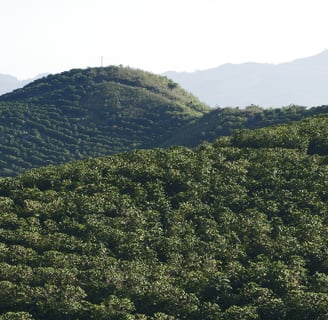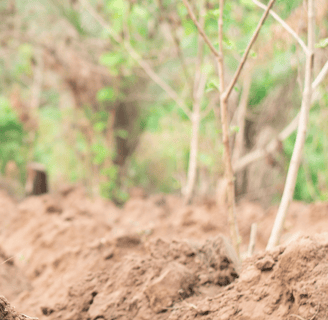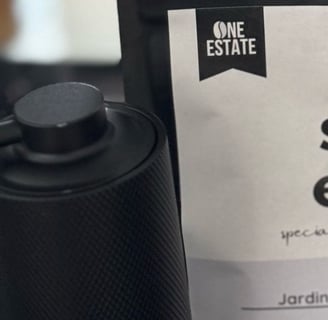
Coffee Terroir: How Geography Shapes Your Coffee Experience
Terroir: The key to single estate's unique taste. At One Estate Coffee, we know it's everything.
Ashok Srisenthuran
4/21/20255 min read


Coffee Terroir: How Geography Shapes Your Coffee Experience
Wine enthusiasts have long celebrated the concept of "terroir"—the environmental factors that affect a crop's character—and coffee lovers are increasingly recognizing its profound importance in their own favorite beverage. At One Estate Coffee, terroir is central to our philosophy, as it explains why single estate coffees offer experiences that blends simply cannot match.
Today, we'll explore how the distinct geographies of our two partner estates—Jardin de Claude in Thailand and Boun Thateng in Laos—create completely different but equally extraordinary coffees, even when other factors like processing methods are similar.
What Exactly Is Coffee Terroir?
Terroir (pronounced "tehr-wahr") comes from the French word "terre," meaning earth or land. In the context of coffee, it encompasses all the environmental factors that influence how coffee grows and, consequently, how it tastes:
Soil composition and geology
Altitude
Climate and weather patterns
Surrounding vegetation
Topography and slope orientation
Rainfall amounts and distribution
Temperature fluctuations
These elements interact in complex ways, creating growing conditions unique to each location. Just as humans are shaped by both genetics and environment, coffee beans reflect both their variety (genetics) and where they were grown (environment).
A Tale of Two Terroirs
Our two partner estates provide a perfect case study in how terroir manifests in the cup. Located in neighboring countries but in different regions with distinct geological histories, Jardin de Claude and Boun Thateng produce coffees that tell very different stories.
Jardin de Claude: Thailand's Northern Highlands
Location: Doi Saket, Northern Thailand Altitude: 1,200 meters above sea level Soil Type: Mineral-rich mountain soil Climate: Cooler temperatures with distinct wet and dry seasons Surrounding Ecosystem: Mixed forest with significant biodiversity Geographic Feature: Mountain highlands near the Golden Triangle
Boun Thateng: Laos' Volcanic Plateau
Location: Paksong, Southern Laos Altitude: 1,300 meters above sea level Soil Type: Volcanic soil from ancient eruptions Climate: Moderate temperatures with higher rainfall Surrounding Ecosystem: Native forest adapted to volcanic terrain Geographic Feature: Bolaven Plateau, formed by volcanic activity
How Terroir Translates to Flavor
When we compare coffees from these two distinct terroirs, we can trace specific flavor characteristics directly back to their growing environments:
Altitude: The Higher, The Different
Both estates sit at elevations above 1,200 meters, placing them firmly in the range considered ideal for specialty coffee production. At these heights, coffee cherries develop more slowly due to cooler temperatures, allowing more time for complex flavor compounds to form.
The 100-meter difference between our estates might seem minimal, but combined with other factors, it contributes to distinct development patterns. The slightly higher elevation at Boun Thateng can mean more pronounced acidity, while Jardin de Claude's perfect balance of altitude and temperature creates ideal conditions for fruit-forward notes to develop.


Soil: The Foundation of Flavor
Perhaps the most dramatic difference between our estates lies beneath the surface:
Jardin de Claude's mountain soil is rich in minerals accumulated over centuries. This balanced soil profile supports the development of diverse flavor compounds, contributing to the estate's remarkably varied flavor notes ranging from tomato and roselle tea to wild honey and tropical fruits.
Boun Thateng's volcanic soil contains high levels of phosphorus, potassium, and other minerals from ancient volcanic activity. This distinctive soil imparts a characteristic brightness and slight mineral acidity to the coffee, underpinning the chocolate and nutty notes with a structure reminiscent of fine wine from volcanic regions.
Climate and Weather Patterns
Northern Thailand and Southern Laos experience different weather patterns despite their relative proximity:
Jardin de Claude benefits from Thailand's northern climate, with more pronounced cool seasons and specific rainfall patterns influenced by mountain geography. These conditions create stress periods for the coffee trees that, when managed properly, enhance flavor development—similar to how grape vines produce more complex fruit when moderately stressed.
Boun Thateng experiences the climate of the Bolaven Plateau, where altitude moderates the tropical heat and volcanic soil retains moisture differently. This creates a growing environment that particularly favors the development of the rich, earthy qualities found in their Yellow Caturra.
Same Variety, Different Terroir
To truly understand terroir's impact, consider how the same coffee variety might express itself differently in each location:
If we were to plant Bourbon variety (currently grown at Jardin de Claude) in both locations, we would still end up with noticeably different coffees. In Thailand, the Bourbon might emphasize its bright, sweet characteristics, while in Laos' volcanic soil, the same genetic material would likely develop more pronounced chocolate notes and distinctive minerality.
Processing Through the Lens of Terroir
Both our partner estates use similar processing methods—including natural, washed, honey, and anaerobic fermentation—but each method interacts differently with the base characteristics imparted by terroir:
Natural Processing at Jardin de Claude enhances the inherent fruity sweetness present in beans grown in their specific terroir, creating cups with pronounced notes of wild honey, berries, and tropical fruits.
Natural Processing at Boun Thateng works differently with their terroir-driven characteristics, amplifying the chocolate and nutty foundation while adding subtle fruit complexity to balance the coffee's natural earthiness.
This is why copying processing methods from one region to another rarely produces identical results—the underlying terroir always asserts itself as the foundation upon which processing builds.
Tasting Terroir: A Practical Guide
When you brew coffees from our two estates side by side, you're tasting geography in your cup. Here's what to look for in this comparative tasting:
Jardin de Claude (Thailand)
First impression: Bright, complex fruitiness
Body: Medium with silky texture
Acidity: Vibrant but balanced
Distinctive notes: Wild honey, roselle tea, tropical fruits
Finish: Clean with lingering sweetness
Boun Thateng (Laos)
First impression: Rich earthiness with chocolate depth
Body: Medium-full with round mouthfeel
Acidity: Moderate with mineral brightness
Distinctive notes: Nutty, chocolate, subtle citrus undertones
Finish: Smooth with pleasant complexity
Each of these characteristics can be traced back to specific aspects of terroir—from soil composition to altitude to climate patterns.


The Preservation of Place
This exploration of terroir explains why One Estate Coffee is committed to single estate sourcing. When coffees from different terroirs are blended together, the distinctive geographic signatures become muted or lost entirely, replaced by a homogenized flavor profile.
By preserving the integrity of each estate's coffee, we're not just maintaining flavor clarity—we're honoring the unique environmental conditions that created it and the farmers who have learned to work in harmony with their specific piece of earth.
Looking Forward: Terroir Through Time
Terroir isn't static. Climate change, soil management practices, and surrounding ecosystem changes can all influence how a particular location expresses itself through coffee. This is why our partner farmers' commitment to sustainable practices is so crucial—they're preserving not just environmental health but the distinctive terroir that makes their coffee special.
By supporting single estate coffee, you're participating in this preservation of place, encouraging farming practices that maintain the health and distinctiveness of these remarkable growing environments for generations to come.
Next time you brew a cup from either Jardin de Claude or Boun Thateng, take a moment to consider the journey that brought those flavors to your cup—not just through processing and roasting, but through the very soil, air, and water of a specific place on earth, tended by farmers who understand their unique corner of the coffee world.
Next month: We'll take a closer look at harvesting methods at our partner Small Batch Roaster and how the careful picking of perfectly ripe cherries lays the foundation for exceptional coffee as well as roasting with intention of preserving the flavor in every bean.
© 2024. One Estate. All rights reserved.


